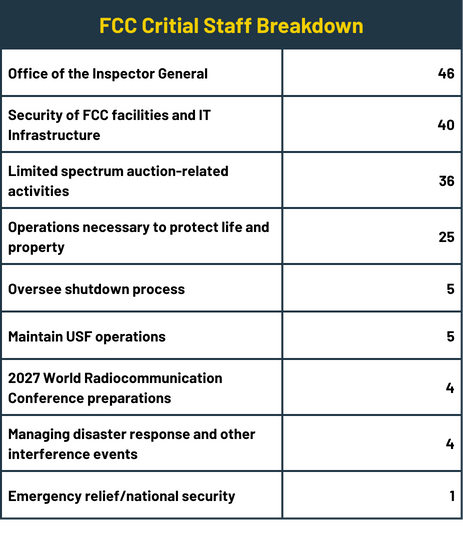For the telecom industry, the government shutdown that started October 1 will have significantly more impact on the FCC than it will on the National Telecommunications and Information Administration, at least as it relates to broadband.
Impact: Furloughs at the FCC will leave the agency at just 22% capacity, with all but 171 of nearly 1,500 staff members deemed non-essential, but the NTIA (and the BEAD program) will fare better because many of its programs run on funding independent from the annual budget. Under the FCC shutdown plan, staff still working will be tasked with maintaining critical functions, which the agency summarized in a document released in March. Crucial activities include those necessary for the protection of life or property, some spectrum auction duties, management of the Universal Service Fund, international/treaty-related activities, and some inspector general operations.

Not subject to furlough because they’re presidential appointments: the FCC Chairman, other commissioners, and the inspector general. A report from legal firm Nelson Mullins indicated that this FCC shutdown differs from others because it involves a “more immediate and substantial curtailment of activity” compared to previous events where the FCC used surplus funds from a variety of sources to keep things open.
Enforcing the shutdown plans means a wide range of the FCC’s regular activities will be impacted, including consumer complaint response, consumer protection and other enforcement activities, wireless and wireline licensing, and equipment authorizations. Fierce Network reported on a research note from New Street Research analyst Blair Levin that said he expects short-term effects on the agency related to device certifications, spectrum licensing, and policy development. Approvals for both pending and new deals in the telecom M&A pipeline also will be put on hold and could still face delays even once the shutdown ends until the backlog gets cleared. But Levin predicted that long-term effects on the agency and its activities would be negligible. But Chairman Brendan Carr said last week that the commission is “crunching the numbers” to ascertain how much funding it has on hand. Even so, work will continue in a number of areas related to the Supply Chain Reimbursement program, international treaty-related work (WRC 2027 prep), Universal Service Fund and other disbursements, certain OIG operations, and most electronic filing systems. USF operations, including the Lifeline, E-Rate, RHC and High-Cost programs, will also dodge interruption because they’re funded separately.
With a number of programs funded by Congressional appropriations rather than through the annual budget, the NTIA should fare better and be able to maintain a mostly business as usual stance for a number of its programs. Those exempt from the shutdown in this case include BEAD and a variety of others (the Enabling Middle Mile Broadband Infrastructure Program, the Digital Equity Act Tribal program, the Tribal Broadband Connectivity Grant program, the Broadband Infrastructure Program, the Connecting Minority Communities program, and the FirstNet Authority). The fact that the NTIA will be able to continue its work on the BEAD program is good news for state broadband offices and providers waiting on final proposal approvals so they can start deploying high-speed broadband service in project areas around the country. That should theoretically prevent BEAD from being impacted by even more delays, though states still need to deal with the best and final offer round of funding as NTIA combs through final approvals and looks for areas to enforce additional cost-cutting.
